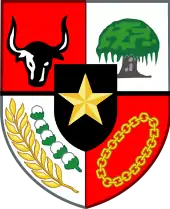Liberal democracy period in Indonesia
The era of Liberal Democracy (Indonesian: Demokrasi Liberal) in Indonesia began on 17 August 1950 following the dissolution of the federal United States of Indonesia less than a year after its formation, and ended with the imposition of martial law and President Sukarno's decree regarding the introduction of Guided Democracy on 5 July 1959. It saw a number of important events, including the 1955 Bandung Conference, Indonesia's first general elections and Constitutional Assembly elections, and an extended period of political instability, with no cabinet lasting as long as two years.
Part of a series on the |
|---|
| History of Indonesia |
   |
| Timeline |
|
|
Post-independence struggles
With the unifying struggle to secure Indonesia's independence now over, divisions in Indonesian society began to appear. Regional differences in customs, morals, tradition, religion, the impact of Christianity and Marxism, and fears of Javanese political domination, all contributed to disunity. The new country was typified by poverty, low educational levels, and authoritarian traditions.[1] Various separatist movements opposed the Republic of Indonesia: the militant Darul Islam ('Islamic Domain') proclaimed an "Islamic State of Indonesia" and waged a guerrilla struggle against the Republic in West Java from 1948 to 1962; in Maluku, Ambonese formerly of the Royal Netherlands East Indies Army proclaimed an independent Republic of South Maluku; and rebellions in Sumatra and Sulawesi between 1955 and 1961.
The economy was in a disastrous state following three years of Japanese occupation then four years of war against the Dutch. In the hands of a young and inexperienced government, the economy was unable to boost production of food and other necessities to keep pace with an increasing population. Most of the population was illiterate, unskilled, and suffered from a dearth of management skills. Inflation was rampant, smuggling cost the central government much needed foreign exchange, and many of the plantations had been destroyed during the occupation and war.[2]
Constitutional arrangements and parliamentary democracy
The Provisional Constitution of 1950 differed markedly from the 1945 Constitution in many ways; it mandated a parliamentary system of government, and stipulated at length constitutional guarantees for human rights, drawing heavily on the 1948 UN's Universal Declaration of Human Rights.[3] It was abrogated on 9 July 1959 when President Sukarno issued a decree dissolving the Constitutional Assembly and restoring the 1945 Constitution of Indonesia.[4]
A proliferation of political parties and the deals brokered between them for shares of cabinets seats resulted in rapid turnover coalition governments including 17 cabinets between 1945 and 1958. The long-postponed parliamentary elections were finally held in 1955; the Indonesian National Party (PNI)—considered Sukarno's party—topped the poll, and the Communist Party of Indonesia (PKI) received strong support, but no party garnered more than a quarter of the votes, resulting in short-lived coalitions.[2]
Guided democracy
By 1956, Sukarno was openly criticising parliamentary democracy, stating that it was 'based upon inherent conflict' that ran counter to the Indonesian concept of harmony as the natural state of human relationships. Instead, he sought a system based on the traditional village system of discussion and consensus, which occurred under the guidance of village elders. He proposed a threefold blend of nasionalisme ('nationalism'), agama ('religion'), and komunisme ('communism') into a co-operative 'Nas-A-Kom' government. This was intended to appease the three main factions in Indonesian politics – the army, Islamic groups, and the communists. With the support of the military, he proclaimed in February 1957, 'Guided Democracy', and proposed a cabinet of representing all the political parties of importance (including the PKI). Western-style parliamentary democracy was thus finished in Indonesia until the 1999 elections of the Reformasi era.[2]
Timeline

- 1948–62: Darul Islam rebellions begin in West Java, spread to other provinces but conclude with the execution of its leader Kartosoewiryo.
- 1952, 17 October: General Nasution is suspended as army chief of staff following army indiscipline over command and support that threatens the government.
- 1955, April: The city of Bandung hosts the Bandung Conference. The meeting, which was an important step toward the Non-Aligned Movement, was attended by world leaders including Zhou Enlai of China, Jawaharlal Nehru of India, Gamal Abdel Nasser of Egypt and Josip Broz Tito of Yugoslavia.
- 1955, September: Indonesia holds general parliamentary elections; the last free national elections until 1999; support for the parties is widely distributed with four parties each gaining 16–22 per cent and the remaining votes split between 24 parties.
- 1958, 18 May: US Air Force pilot Allen Pope is shot down over Ambon, revealing covert American support of regional rebellions, and ends the Dulles brothers', Allen and John, failure to subvert the Sukarno government. Pope sunk the Indonesian Navy vessel, the KRI Hang Toeah, and heavily damaged its sister, the KRI Sawega. Bailed out and captured by Indonesian armed forces on board the KRI Pulau Rengat.
- 1950s/60s: The military articulate the doctrines of dwifungsi and hankamrata: i.e. a military roles in the country's socio-political development as well as security; and a requirement that the resources of the people be at the call of the armed forces.
- 1959, 5 July: With armed forces support, Sukarno issues a decree dissolving the Constituent Assembly and reintroducing the Constitution of 1945 with strong presidential powers, and assumes the additional role of Prime Minister, which completes the structure of 'Guided Democracy'.
References
- Ricklefs (1991), page 237
- Witton, Patrick (2003). Indonesia. Melbourne: Lonely Planet. pp. 26–28. ISBN 1-74059-154-2.
- Schwarz, A. (1994). A Nation in Waiting: Indonesia in the 1990s. Westview Press. ISBN 1-86373-635-2.
- Ricklefs (1991), page 270
